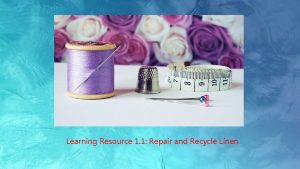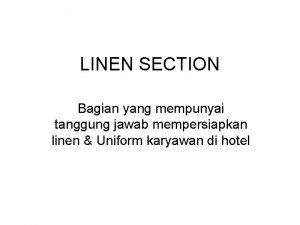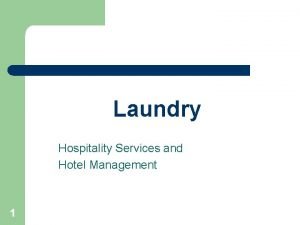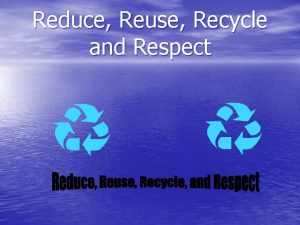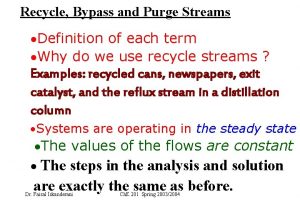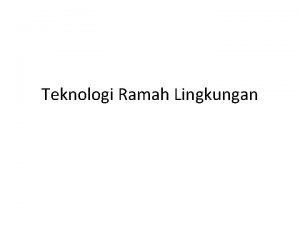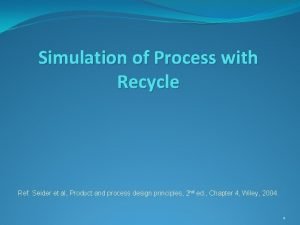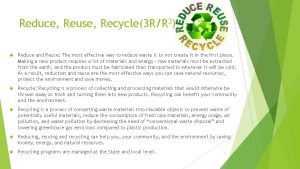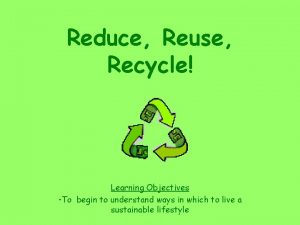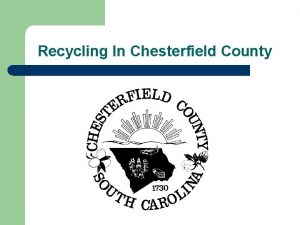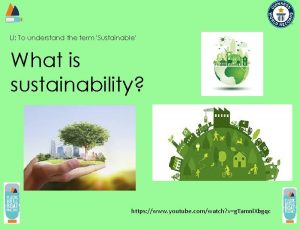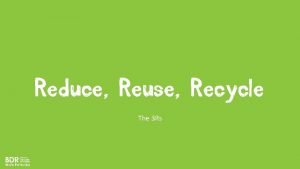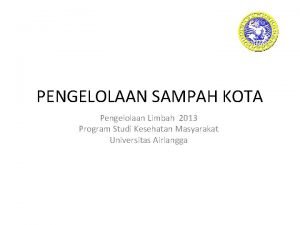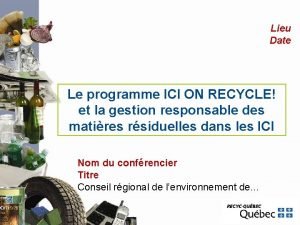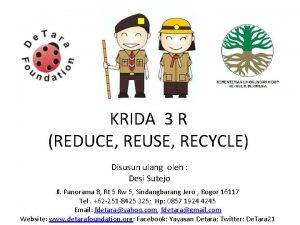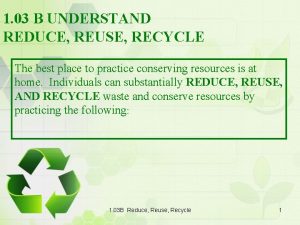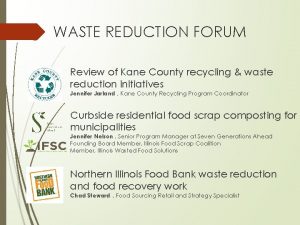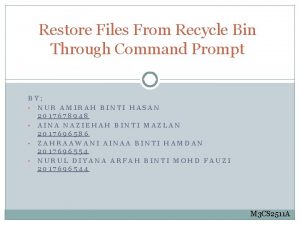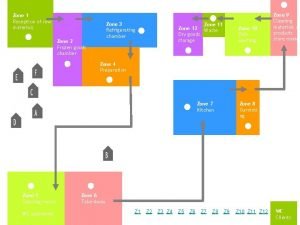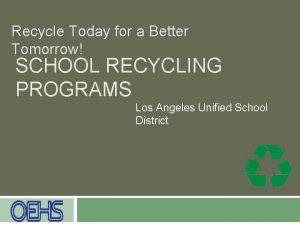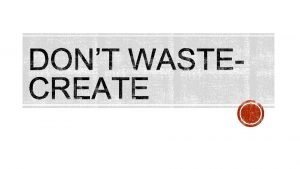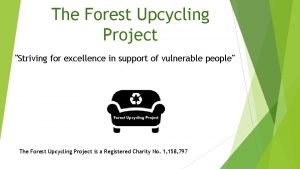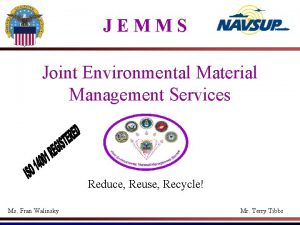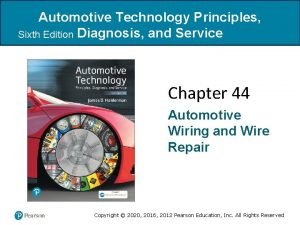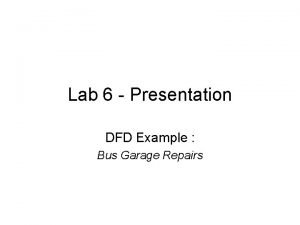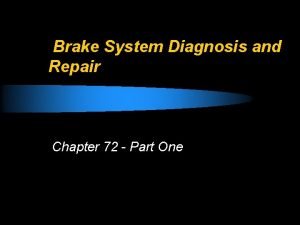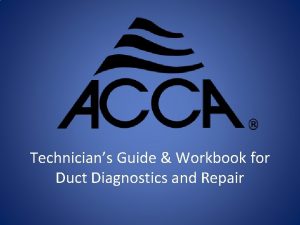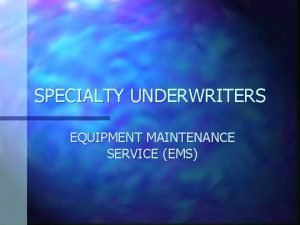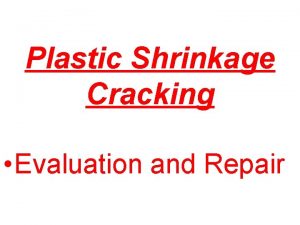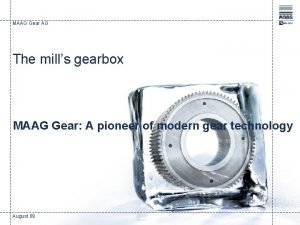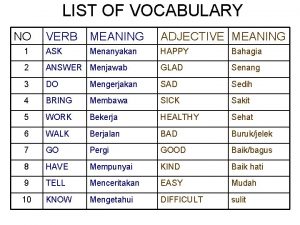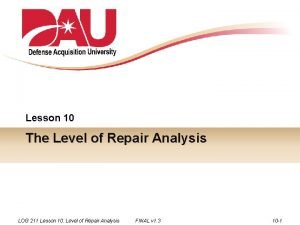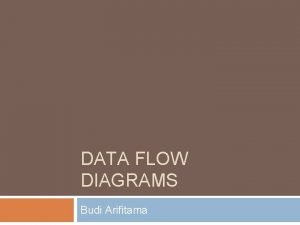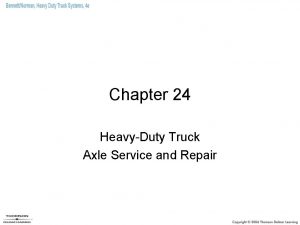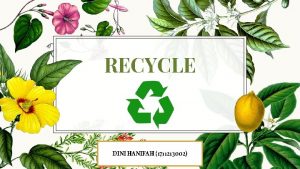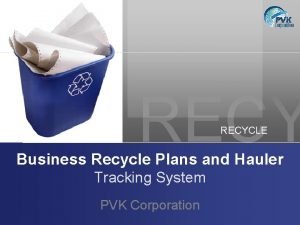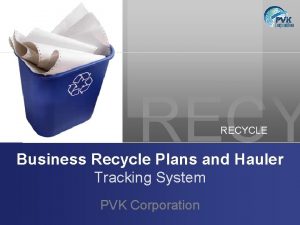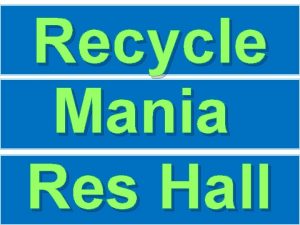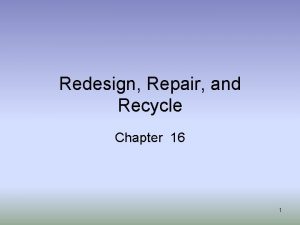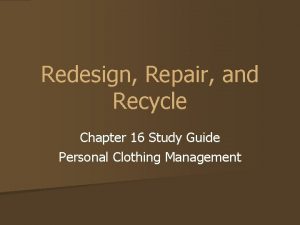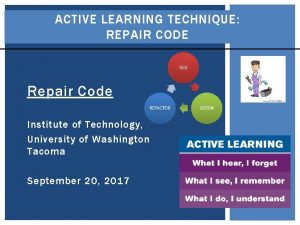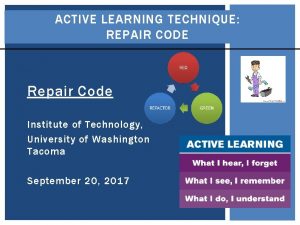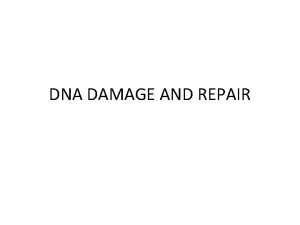Learning Resource 1 1 Repair and Recycle Linen









































































- Slides: 73

Learning Resource 1. 1: Repair and Recycle Linen

Learning Objectives At the end of this learning resource trainees should be able to: üIdentify the different methods used to repair items after viewing Power. Point presentation at 100% accuracy according to industry standards. üExpound on when to use the following methods of repair namely darning, stitching and patching at 100% accuracy after engaging in Power. Point presentation. üExpound on the importance of recording items collected to be repaired after engaging in Power. Point activity at 100% accuracy. üIdentify the different types of repairs that might be required based on industry standards with at least 90% accuracy after engaging in video presentation entitled “How to mend sheet and ripped clothing”. Learning Resource 1. 1: Repair and Recycle Linen 2

Learning Objectives Cont’d üIdentify at least two (2) types of sewing machine that might be needed to complete repairs after viewing Power. Point presentation according to industry standards at 100% accuracy. üElaborate on at least three (3) repercussions of errors in repairs at 100% accuracy according industry standards after viewing Power. Point presentation. üDefine patching, stitching and darning after engaging in presentation at 100% accuracy according to industry standards. Learning Resource 1. 1: Repair and Recycle Linen 3

Learning Resource 1. 1: Repair and Recycle Linen 4

Introduction Items to be repaired in the hospitality industry may range all the way from sewing on a button to mending a hole or a tear in a best dress or suit. Methods and devices used for repairs vary with different problems and materials; however the old practice of mending each rent or hole soon after the damage is done, and using patches or darning to fill them, still holds as a fundamental principle. The purpose of this is to highlight the repair and recycling of linen. Learning Resource 1. 1: Repair and Recycle Linen 5

When guest items are received, checked and sorted in the initial process it may be noted that some garments may require minor repairs. Any items that have been identified for minor repairs will be sent to the sewing department after washing but before being pressed. Minor repairs might be required such as the replacement of missing buttons and stitching hems and are usually done free of charge. Learning Resource 1. 1: Repair and Recycle Linen 6

If the guest requests that hems be shortened or zips replaced, then this may be done, but at an additional cost. The hotel should have a price list for these alterations so that guests can be aware of the charges to be incurred. Alterations should only be carried out by a qualified competent seamstress as any damage done to garments may need to be replaced at a cost to the hotel. Learning Resource 1. 1: Repair and Recycle Linen 7

It is important to keep a stock of sewing threads, zips and buttons of different colours and styles so these requests may be met. Repairing is the process of restoring something that is damaged, faulty or worn to a good quality. Recycling is the process of converting items considered waste into reusable materials. For example irremovable stains on sheets or pillow cases could be converted into Learning Resource 1. 1: Repair and Recycle Linen 8

Guest might ask for repairs to be done to their garment. Most repairs are done using either of the following: üDarning üPatching üStitching Learning Resource 1. 1: Repair and Recycle Linen 9

Repairs to Hotel Linens Learning Resource 1. 1: Repair and Recycle Linen 10

Large laundries may have access to their own sewing room where one or several seamstresses work. There will need to be several different styles of sewing machines such as a: üstraight stitcher ühemmer üoverlocker In order to carry out repairs for guests. Where there is no sewing room the hotel may contract out their repairs for a fee. Learning Resource 1. 1: Repair and Recycle Linen 11

Garment must be restored to its optimum condition when being repaired; this repair should restore strength and be as invisible as possible. Invisible mending is most times used to make repairs as attractive as possible. When repairing an underarm split you should follow the following procedure: üUnpick seams of sleeve and bodice as far as weakened portion extends. Learning Resource 1. 1: Repair and Recycle Linen 12

üIn the case of a split seam, you should unpick the stitching on each side of the split in the seam to provide thread for fastening off properly. üApply print patch to worn sections, shaping unstitched edges to match those of the worn portion. (Additional matching patch shapes are cut for the opposite bodice and sleeve, whether necessary or not, and for the back of the damaged side if not included in the repair, in order to resemble a gusset under both arms). üRe-stitch seams. Learning Resource 1. 1: Repair and Recycle Linen 13

Invisible Mending- This is a weaving method where the fabric is rebuilt following a damage caused by a scissor cut or burn. Learning Resource 1. 1: Repair and Recycle Linen 14

A Bodice-usually fitted vest or wide, lace -up girdle worn by women over a dress or blouse, especially a cross-laced, sleeveless outer garment covering the waist and bust, common in peasant dress. The part of a woman's dress covering the body between the neck or shoulders and the waist. Learning Resource 1. 1: Repair and Recycle Linen 15

Ensure when using equipment it is used safely. Follow the manufactures instructions for the use of all equipment. Ensure to wear proper personal protective equipment when carrying out tasks. Once the guest has given you their garment to be repaired; it is your responsibility to store and handle these items with care. Store them safely during the repairing process, away from anything that can stain or damage the fabric in any way. Store them in designated areas or on hang them on hangers. Learning Resource 1. 1: Repair and Recycle Linen 16

As soon as items are collected for repairs as requested; count the pieces and record, record the request given for repairs once noted by the guest, the room number and the name of the guest accurately so that items can be returned to the appropriate person and room. Once items are collected pockets should be checked for any extraneous objects. If there are objects in the pockets of items, dispose of them or return immediately to guests( if regarded as important) and make note of return. Learning Resource 1. 1: Repair and Recycle Linen 17

Extraneous objects-items that do not belong or are not relevant. Outside items such as money in pockets, receipts in jacket pockets or napkins. Learning Resource 1. 1: Repair and Recycle Linen 18

Errors in repairs and damage to guests linen can result in: üLawsuits-the organization can be sued for damage to guests clothes or loss of items. üLack of business-This can damage the reputation of the organization resulting in a loss of business. Learning Resource 1. 1: Repair and Recycle Linen 19

üComplaints-Guest can file complaints about poor service. üLoss of income for employees as the item might need to be replaced at the cost of the employees due to negligence. Learning Resource 1. 1: Repair and Recycle Linen 20

Repairs are done also to linen within the hotel. From day to day there will be constant wear and tear on hotel items used daily and these too will need repairs. Depending on the damage to linen, it may be possible that some may be repaired or remade. The standard of acceptable repair must be decided by all relevant parties. What is an acceptable repair for a two star motel may not be acceptable for a five star international hotel. Learning Resource 1. 1: Repair and Recycle Linen 21

Examples of repairs done to linen: üWhere a large sheet is torn on the outer edge , the sheet may be repaired by sewing, as this part of the sheet will not be seen when the bed is made as it will be tucked in. üIf damage to the sheet is closer to the centre, the remaining fabric can be measured and possibly remade into a smaller sheet. For example, a king size or a queen size sheet could be made into a single sheet. Learning Resource 1. 1: Repair and Recycle Linen 22

üIf a sheet is torn in the middle but the body of the fabric is still in good condition, this may be remade into cot sheets for babies or into pillow cases üSmall holes on bed linen may be machine darned but it must be determined how many darns is acceptable before the sheet is condemned and taken out of service Learning Resource 1. 1: Repair and Recycle Linen 23

üSimilarly, large towels can be remade into hand towels and face washers by overlocking the edges. üOld towels may have a line of coloured stitching sewn through one end and be used for staff towels or in the hotel gymnasium. üLarge banquet tablecloths may be remade into smaller tablecloths or tray mats. üCondemned table cloths can be remade into chefs' aprons with the addition of apron ties. üCondemned sheeting may be remade into chefs' Learning Resource 1. 1: Repair and Recycle Linen 24

Whilst sewing is an option, some laundries choose to repair linen with heat patches. These are white pieces of fabric that are applied over a hole and adhered by a heat machine. The end result is not as professional as sewing but is a satisfactory option for many companies. This process can also be used to mend some staff uniforms üOld mattress protectors can be cut and sewn and made in to oven cloths. üAll condemned and discarded linen could eventually be used for cleaning cloths. Learning Resource 1. 1: Repair and Recycle Linen 25

Opening Learning Activity Watch the following video by Gunold. USA (2015), Using Heat 'n Seal to Repair Holes in a Garment, retrieved November 8, 2019 from https: //www. youtube. com/watch? v=HJof_ltx 8 G 4 Watch the following video by SEW ALDO (2017), How to mend ripped clothing and bed sheets, retrieved November 8, 2019 from https: //www. youtube. com/watch? v=HJof_ltx 8 G 4 Have fun learning Learning Resource 1. 1: Repair and Recycle Linen 26

Opening Learning Activity Read the following article by Rocke, H (1938), "EC 462 Repair of Clothing and Household Linens“, retrieved November 8, 2019 from https: //digitalcommons. unl. edu/cgi/viewcontent. cgi? article=3177&context=extensionhist ü Working with your partner identify THREE (3) essential items needed when mending. ü Discuss the TWO (2) types of darning identified. Have fun learning Learning Resource 1. 1: Repair and Recycle Linen 27

Learning Activity Learning Resource 1. 1: Repair and Recycle Linen 28

Learning Activity What was said is the secret to hand darning? Click a response A Keep stitching on the right hand side going in the same direction? B Use of thread as nearly like the material in texture and color as possible C Using thread, choose a shade darker in color than the material Next Question Learning Resource 1. 1: Repair and Recycle Linen 29

CORRECT GO BACK TO PREVIOUS Learning Resource 1. 1: Repair and Recycle Linen 30

INCORRECT GO BACK TO PREVIOUS Learning Resource 1. 1: Repair and Recycle Linen 31

Learning Activity There are THREE (3) kinds of tears that are normally mended. What are they? A Click a response The diagonol, top to bottom and circle B The diagonol, straight and three cornered tear C The cornered tear, side tear and three cornered tear Next Question Learning Resource 1. 1: Repair and Recycle Linen 32

CORRECT GO BACK TO PREVIOUS Learning Resource 1. 1: Repair and Recycle Linen 33

INCORRECT GO BACK TO PREVIOUS Learning Resource 1. 1: Repair and Recycle Linen 34

Learning Activity When is the patching method used in repairing? Click a response A When the seamstress decides to use it B Where the fabric is ripped diagonally C Where the hole in the fabric is too large to be filled with threads of the material. Next Question Learning Resource 1. 1: Repair and Recycle Linen 35

CORRECT GO BACK TO PREVIOUS Learning Resource 1. 1: Repair and Recycle Linen 36

INCORRECT GO BACK TO PREVIOUS Learning Resource 1. 1: Repair and Recycle Linen 37

Learning Activity What precaution should you pay attention to when using the stitching or mending method for doing repairs? Click a response A Try not to pull the thread too tight or the darn will pucker B The type of thread C The type of fabric used Next Slide Learning Resource 1. 1: Repair and Recycle Linen 38

CORRECT GO BACK TO PREVIOUS Learning Resource 1. 1: Repair and Recycle Linen 39

INCORRECT GO BACK TO PREVIOUS Learning Resource 1. 1: Repair and Recycle Linen 40

Darning-the act of mending a hole in a garment with crossing threads Learning Resource 1. 1: Repair and Recycle Linen 41

You should follow the rules for all darns: üThe thread used should match the garment in colour and texture, e. g. woolen yarns on woolen cloth, and cotton thread on cotton material. üDarning should be worked on the wrong side, selvedge (warp) direction first. üAn irregular shape should be worked to avoid strain on any one thread (except in the case of a hedge-tear where surrounding threads are not worn). Learning Resource 1. 1: Repair and Recycle Linen 42

üLoops should be left at the end of each row to allow the garment to stretch or allow the new thread to shrink without pulling the darn tightly. üThe completed darn must be large enough to cover the hole and the surrounding worn parts. Learning Resource 1. 1: Repair and Recycle Linen 43

Patching is a useful method of repairing outer garments made of cotton, wool, silk, rayon, nylon and linen. On printed or woven patterns it can almost be invisible. You should follow the rules for all patches: üThe patch should be cut perfectly square and large enough to cover the hole and all surrounding worn part. Learning Resource 1. 1: Repair and Recycle Linen 44

üThe patching material must match that of the garment in pattern colour and texture. New material used should be washed if the garment has been washed, and gently bleached if the colour of the garment is faded. Learning Resource 1. 1: Repair and Recycle Linen 45

Patching-the act of mending a hole in a garment by sewing a patch under or over it Learning Resource 1. 1: Repair and Recycle Linen 46

Stitching is also a method of repair and can be used to describe both a row of stitches and the process of sewing. There are several types of stitching that is used for repairs: üRunning stitch-This is used for gathering, mending and tucking. üBasting stitch-This is used on hem lines to keep them flat üBackstitch Learning Resource 1. 1: Repair and Recycle Linen 47

üZig Zag stitch-This provides a clean finish for raw edges üCross stitch-This is used to finish hems. üSlip Stitch- This stitch is almost invisible and used on hems as well. üButtonhole stitch- This is used to mend button holes so the fabric does not fray. Learning Resource 1. 1: Repair and Recycle Linen 48

MAINTENANCE AND REPAIR OF GARMENTS Learning Resource 1. 1: Repair and Recycle Linen 49

Customers will require varying levels of repairs to be done to their garments. You may be required to repair: ü Split seams üUnderarm slits üFrayed buttonholes üWorn crotch on trousers, jeans üBroken shoulder straps üBroken zippers, loops, ribbons and tapes Learning Resource 1. 1: Repair and Recycle Linen 50

When collecting items from guests for repairs, ensure to greet the guest according to industry standards( Good Morning Mrs. Jones, how are you? ”). Knock before entering at least three (3) times and announce your department. Once guest grants permission you may enter. Use the guest name throughout any conversation had with the guest so guest will feel like they are getting personalized service. Learning Resource 1. 1: Repair and Recycle Linen 51

Once items are collected and guest has given you details on the items that needs repairing, discussions may be had with guests regarding suggested repairs for damages seen, so guests can have an idea of what needs to be done. Count pieces in the presence of the guest and complete necessary documentation so it can be confirmed the amount of pieces collected. Tag items immediately to prevent any confusion or possible mix-up with linen. Learning Resource 1. 1: Repair and Recycle Linen 52

Prepare Garment For Storage Learning Resource 1. 1: Repair and Recycle Linen 53

After garments have been repaired, dry-cleaned, laundered or spot cleaned, you may be required to store such garments until the customer picks them up. You should: üCount, describe and tag each item with an identification card with the customers name, address, telephone number etc. üLog the date the item/s is to be picked up Learning Resource 1. 1: Repair and Recycle Linen 54

It is important to store items accurately according to industry standards after alterations or repairs are complete. Ensure to: üTack down pleats where necessary üUse moth-deterrent if necessary üEnsure that clothes are perfectly dry before storing üPut on hanger and cover with polythene bag üStore item in a hanging closet Learning Resource 1. 1: Repair and Recycle Linen 55

When returning guest items ensure the proper documentation is completed and taken according to industry standards. Knock and announce the department before entry. Once permission is given greet guest appropriately and proceed to confirm repairs with guests. Match the records of the amount of pieces taken from the guest and the amount returned to ensure it is accurate. Complete all necessary paperwork before leaving. Learning Resource 1. 1: Repair and Recycle Linen 56

Once repairs are completed and it is time for delivery, ensure items are tagged appropriately and correctly. Double check all pieces in an attempt to prevent dissatisfaction from guests. Learning Resource 1. 1: Repair and Recycle Linen 57

Moth Detergent- anything used to keep moths off garment. Learning Resource 1. 1: Repair and Recycle Linen 58

Opening Learning Activity Read the following article by Baker M, (2007), “Clothing Repair“, retrieved November 11, 2019 from https: //fleming. ca. uky. edu/files/clothing_repair. pdf Have fun learning Learning Resource 1. 1: Repair and Recycle Linen 59

Recycling Learning Resource 1. 1: Repair and Recycle Linen 60

Recycling is the act of reusing something. There are several items that can be recycled in the housekeeping department. They are as follows: üPillow cases üKitchen towels üBed Linen üClothing üTowels Learning Resource 1. 1: Repair and Recycle Linen 61

There are several benefits to recycling linen in the hotel industry. They are as follows: üSaves Money: This allows the organization to reuse items that might be considered damaged for another purpose thus eliminates having to purchase. Old towels can be used as cleaning rags thus eliminating or lessening the purchase of cleaning rags. Learning Resource 1. 1: Repair and Recycle Linen 62

üEliminates land fill waste-Less items are sent to the dump, thus filling up dump sites. üBenefits the environment-Recycling reduces pollution because trash isn’t being burned and manufacturers can reuse materials instead of creating new ones which is more energy efficient. Learning Resource 1. 1: Repair and Recycle Linen 63

Condemning of linen Learning Resource 1. 1: Repair and Recycle Linen 64

Once linen is taken out of stock and discarded, it must be counted and recorded. It is important on a monthly basis to know what has been condemned so that replacement pieces can be placed into circulation to maintain the par levels. If the laundry or hotel operates below par levels, this will cause problems in meeting the requirements of the customers as there will most definitely be shortages. Learning Resource 1. 1: Repair and Recycle Linen 65

Par Level-This is a set amount that you should have all the time Learning Resource 1. 1: Repair and Recycle Linen 66

It is important that the laundry manager check the discarded linen periodically to ensure that it is indeed not recoverable and is not being discarded prematurely. Condemned linen should be carefully counted and recorded every day and monthly totals be given to the laundry manager for review. Learning Resource 1. 1: Repair and Recycle Linen 67

Prepare and Maintain Records and Reports Learning Resource 1. 1: Repair and Recycle Linen 68

It is important that once a customer has made a request or given n item to be repaired it is appropriately recorded. Your organization may have an established method of recording information. Some organizations use log books, diaries or specially designed forms while others will use computer generated packages. Database and spreadsheets are often used. Information that should be recorded is as follows: Learning Resource 1. 1: Repair and Recycle Linen 69

üThe customer’s name, address and telephone number. üThe date üThe request, type of repair to be done üThe number of items, type, fibre content, colour. üThe name of person who dealt with the request üThe action taken/recommendations made ü Who took the action Learning Resource 1. 1: Repair and Recycle Linen 70

Congratulations! You have completed Learning Resource 1. 1. You may now move on to Learning Resource 1. 2. Learning Resource 1. 1: Repair and Recycle Linen 71

References üBaker, M. “How to Make a New Hem and How to Patch Knees in Pants”, 1978, by University of Kentucky Cooperative Extension , retrieved November 2019 from , https: //fleming. ca. uky. edu/files/clothing_repair. pdf üGunold. USA (2015), Using Heat 'n Seal to Repair Holes in a Garment, retrieved November 2019 from https: //www. youtube. com/watch? v=HJof_ltx 8 G 4 üRocke, H. "EC 462 Repair of Clothing and Household Linens" (1938). Historical Materials from University of Nebraska-Lincoln Extension. 2154. https: //digitalcommons. unl. edu/extensionhist/2154 üSEW ALDO (2017), How to mend ripped clothing and bed sheets, retrieved November 2019 from https: //www. youtube. com/watch? v=HJof_ltx 8 G 4 Learning Resource 1. 1: Repair and Recycle Linen 72

References Cont’d üWilliam Anglis Institute (2010). “Laundry “ D 1. HBS. CL 5. 10. Trainee Manual. Pub. Asean Australian AID. Retrieved 2019 from file: ///E: /ETMU/Housekeeping/Clean%20 bedroom%20 and%20 Public %20 Areas/TM_Clean_&_prepare_rooms_for_incoming_guests_2708 12. pdf Learning Resource 1. 1: Repair and Recycle Linen 73
 Linen repair
Linen repair Excision repair
Excision repair Base excision repair
Base excision repair Steel tape in surveying
Steel tape in surveying Linen girdle
Linen girdle Linen girdle
Linen girdle Linen section adalah
Linen section adalah Laundry service in hotel industry
Laundry service in hotel industry Egyptian linen clothing
Egyptian linen clothing Deacon stole meaning
Deacon stole meaning Resource leveling is the approach to even out the peaks of
Resource leveling is the approach to even out the peaks of Perbedaan antara resource loading dan resource levelling
Perbedaan antara resource loading dan resource levelling Cuadro comparativo e-learning m-learning b-learning
Cuadro comparativo e-learning m-learning b-learning Reduce reuse recycle and respect
Reduce reuse recycle and respect Purge stream meaning
Purge stream meaning Pengertian dan prinsip teknologi ramah lingkungan
Pengertian dan prinsip teknologi ramah lingkungan What is a tear stream in aspen
What is a tear stream in aspen 3 benefits of recycling
3 benefits of recycling Objectives of reduce, reuse, recycle
Objectives of reduce, reuse, recycle Recycle chesterfield county
Recycle chesterfield county Recycle acrostic poem
Recycle acrostic poem Short essay on recycling
Short essay on recycling Go recycle yourself
Go recycle yourself Reduce examples
Reduce examples Recycle yaitu
Recycle yaitu Certification ici on recycle
Certification ici on recycle Halimbawa ng reduce
Halimbawa ng reduce Recycle yaitu
Recycle yaitu Make a poster reduce reuse recycle
Make a poster reduce reuse recycle Kane county recycling center
Kane county recycling center Present simple passive recycle
Present simple passive recycle Bootsect bak restore
Bootsect bak restore Growth slump maturity pattern
Growth slump maturity pattern Reception of raw materials
Reception of raw materials Recycle paper
Recycle paper Chestermere bottle depot
Chestermere bottle depot Recycle today for a better tomorrow
Recycle today for a better tomorrow Recycle is important because
Recycle is important because Forest recycle
Forest recycle Kadena recycle center
Kadena recycle center Lagging strand
Lagging strand Chapter 81 brake system technology answers
Chapter 81 brake system technology answers Modified macpherson strut
Modified macpherson strut Peak and hold injector waveform
Peak and hold injector waveform Chapter 44 automotive wiring and wire repair
Chapter 44 automotive wiring and wire repair Bus garage repair dfd level 1
Bus garage repair dfd level 1 337 form example
337 form example Brake pedal reserve distance
Brake pedal reserve distance Auto upkeep answer key
Auto upkeep answer key Repair and restoration theory of sleep
Repair and restoration theory of sleep Repair renovation and restoration of water bodies
Repair renovation and restoration of water bodies Repair theory of sleep
Repair theory of sleep Inductive vs analytical learning
Inductive vs analytical learning Inductive and analytical learning
Inductive and analytical learning Eager learning examples
Eager learning examples Deep learning approach and surface learning approach
Deep learning approach and surface learning approach Air clutch system
Air clutch system Duct repair serpentine
Duct repair serpentine Decompressive laminectomy icd 10
Decompressive laminectomy icd 10 Ems equipment repair
Ems equipment repair Other initiated self repair example
Other initiated self repair example Centurylink control center
Centurylink control center Aci crack repair
Aci crack repair Switchboard maintenance
Switchboard maintenance Maag gearbox repair
Maag gearbox repair Verb 3 of repair
Verb 3 of repair Lru vs sru
Lru vs sru Paraumbilical hernia examination
Paraumbilical hernia examination Chapter 10 lesson 2 nutrients
Chapter 10 lesson 2 nutrients Call 3.hal
Call 3.hal Linea alba hernia
Linea alba hernia Data flow diagram key
Data flow diagram key Culvert repair techniques
Culvert repair techniques Heavy duty truck axle repair
Heavy duty truck axle repair
